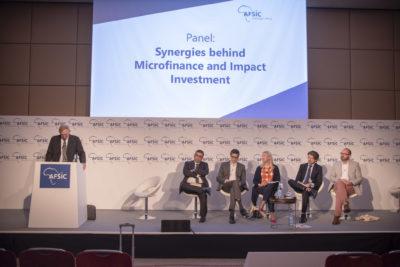May 23, 2019
Looking for synergies behind microfinance and impact investment
Greetings from London and AFSIC! The annual event focuses on matching investors to investment opportunities in Africa. I was honoured to be invited to the panel discussion around impact investment and microfinance. I was also proud to represent the DFI’s point of view in general as we at Finnfund value our microfinance investments from impact perspective.
Finnfund actively looks for investment opportunities in microfinance across the regions we operate in. Through our investment in BOPA we’ve seen how the microfinance institutions target underserved population who wouldn’t otherwise have access to financial services. A large part of the clientele are female entrepreneurs and rural populations.
How impact can be measured
The opening questions were about measuring impact. As a DFI, we want to make sure we put our money where it matters the most. All our investments go through an ex-ante development impact screening before an investment decision is made. This assessment is based on a theory of change. For financial inclusion it takes into consideration country (fragility and low-income status), inclusivity of the finance, gender, environment and how the investment affects availability, affordability and other terms of finance. We also monitor how the size and distribution of our investees’ loan portfolios change over time, if the expected targets were met or not and how women and rural populations are reached. So yes, impact can and needs to be measured.
True or false?
“Impact investing can provide both robust financial returns and social impact” – is this, in your opinion, true or false? Again, from a DFI point of view, it’s not only true but actually an integral requirement already in-built in the definition of impact investing. If an investment doesn’t provide financial returns, it’s called “grant” or “aid”. If it doesn’t generate social impact, it’s no different from mainstream investing. Of course, in impact investments, you sometimes might want to settle with slightly smaller profits if the impact is huge. However, the projects still need to make sense financially. The case I mentioned earlier, BOPA, actually emphasizes the balance between delivering financial returns and solid social impact. We are hoping that ultimately mainstream investing becomes impact investing.
See you in 2020!
This was the seventh year of AFSIC and Finnfund has attended the event every year. You get to meet both existing business partners and co-investors and, of course, prospective investees. My colleague who attended the event the first year told me that it started with around 100 attendees. This year we were more, maybe a thousand. It is one of the key events for us and we are looking forward to participating next year as well – at least I’ve marked my calendar for May 6-8 already! I’m hoping to meet some new participants along with the traditional commercial banks and microfinance institutions, especially promising fintech companies trying to tackle the challenges of financial inclusion in Africa.
Many thanks to Rupert Scofield for moderating the panel and to my fellow panellists: Amro Abouesh (Tanmeyah Microenterprise Services), Eugene du Plessis (Izwe Loans), Steven Duchatelle (Advans Group) and Gregoire Lecomte (Baobab Group). Hope I’ll see you all next year!
Ulla Huotari
Investment Manager, Finnfund

